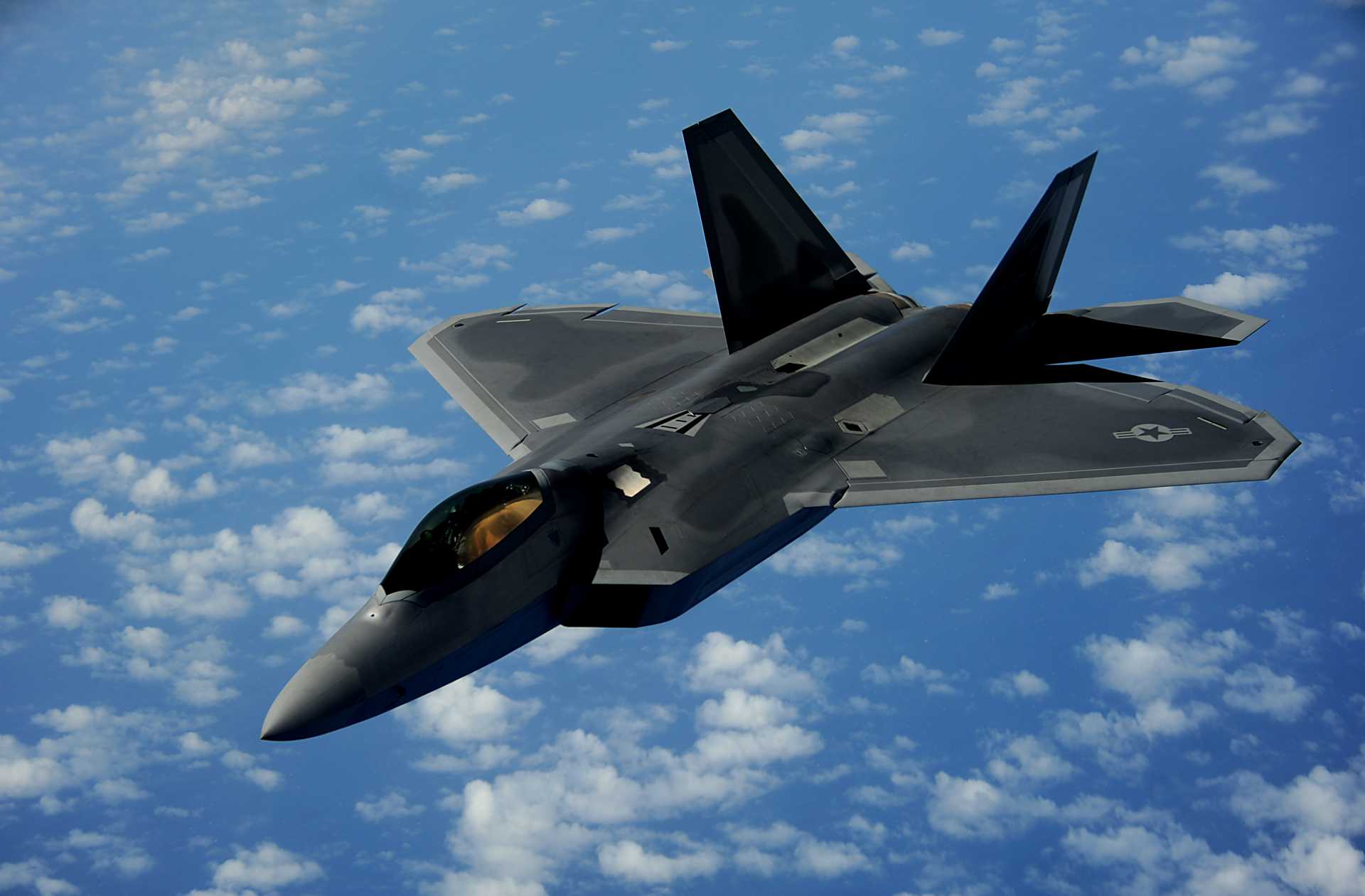Next-Generation Lockheed Martin Infrared Sensors to Boost US F-22 Raptor’s Survivability and Lethality

{loadposition bannertop}
{loadposition sidebarpub}
On January 22, 2025, American company Lockheed Martin (NYSE: LMT) announced that it had received a $270 million contract from the U.S. Air Force to integrate a new generation of infrared defensive sensors on the F-22 Raptor fighter jet. This contract will see the introduction of the Infrared Defensive System (IRDS) on the F-22, a cutting-edge set of embedded infrared sensors that will significantly enhance the aircraft’s survivability and lethality. The system features a distributed array of TacIRST (Tactical Infrared Search and Track) sensors, developed by Lockheed Martin, which are designed to provide an advanced layer of situational awareness and countermeasures against potential threats in both air and ground combat scenarios.Follow Army Recognition on Google News at this link
U.S. Air Force F-22 Raptor Upgraded with Lockheed Martin’s new Next-Generation Infrared Defensive System Enhances Survivability and Combat Effectiveness. (Picture source: U.S. DoD)
Lockheed Martin’s new IRDS technology will augment the F-22’s existing capabilities, allowing it to detect, track, and neutralize a variety of threats with greater precision. The upgraded system will improve the aircraft’s ability to operate in increasingly complex and contested environments, ensuring that it remains a dominant force in the skies. In addition to managing the integration of IRDS on the F-22, Lockheed Martin will also support similar integrations on other platforms across the U.S. Air Force fleet. The company has emphasized that the new technology is crucial in maintaining the air superiority of the U.S. military as it faces evolving threats from potential adversaries.
Hank Tucker, Vice President of Mission Systems at Lockheed Martin, highlighted the importance of IRDS in improving mission survivability for pilots. “We understand the need for advanced and versatile infrared systems like IRDS that will make pilots’ missions more survivable and lethal against current and future adversaries,” Tucker said. This integration effort is part of Lockheed Martin’s continued commitment to innovation and modernization, ensuring that the U.S. Air Force maintains its technological edge in combat situations. Justin Taylor, Vice President of the F-22 program at Lockheed Martin, also expressed the company’s pride in continuing its partnership with the Air Force, particularly in advancing the capabilities of the F-22 to sustain U.S. air superiority.
The F-22 Raptor, a fifth-generation fighter jet, has long been the cornerstone of the U.S. Air Force’s air dominance capabilities. Entering service in 2005, the F-22 was specifically designed to maintain air superiority by combining stealth technology, supercruise (the ability to fly at supersonic speeds without using afterburners), and advanced avionics. These features allow the F-22 to evade radar detection, engage targets at long distances, and outmaneuver adversaries in close combat, all while maintaining a low radar profile. The addition of the IRDS system further enhances these capabilities, ensuring that the F-22 will continue to dominate in the ever-evolving battlefield.
One of the key advantages of the F-22 is its sensor fusion, which allows it to seamlessly integrate data from its radar, infrared systems, and electronic warfare tools. This combination gives the pilot an unparalleled level of situational awareness, allowing them to track and engage enemy aircraft, missiles, and ground-based threats before being detected themselves. The aircraft’s advanced radar, which operates in both air-to-air and air-to-ground modes, works in conjunction with its infrared systems, including the newly integrated IRDS, to provide a complete picture of the battle space.
Compared to other fighter jets in the U.S. Air Force’s fleet, the F-22 Raptor stands out due to its focus on air superiority. While the F-35 Lightning II is also a fifth-generation stealth fighter, it is designed as a multirole aircraft, with a broader mission set that includes close air support, strike missions, and intelligence gathering. The F-22, in contrast, was purpose-built to ensure that the U.S. military maintains unchallenged control of the skies, particularly in high-intensity air-to-air combat scenarios.
In terms of speed and agility, the F-22 outperforms many of its peers. The jet’s thrust-vectoring engines, combined with its lightweight airframe and advanced flight control systems, allow it to perform high-G maneuvers that would be impossible for many other aircraft to match. Its ability to fly at supersonic speeds without using afterburners gives it a significant edge in terms of range and fuel efficiency, while its stealth features ensure it can operate in contested environments without detection.
While the F-22 has been a critical asset for the U.S. Air Force, it is not the only advanced fighter in the service. The F-15EX Eagle II, a modernized version of the iconic F-15, and the F-16 Fighting Falcon, a workhorse of the U.S. Air Force for decades, continue to play vital roles in combat operations. However, both of these aircraft lack the F-22’s level of stealth, sensor fusion, and supercruise ability. The F-15EX and F-16, while highly capable and versatile, are designed more for multirole missions, including air-to-ground operations, rather than pure air dominance. In terms of pure air-to-air combat capability, the F-22 remains the undisputed leader of the U.S. Air Force’s fleet.
Lockheed Martin’s ongoing role in modernizing the F-22 ensures that the aircraft will remain at the cutting edge of technology. As the Air Force works to extend the service life of the F-22, integrating new systems like the IRDS is critical in ensuring that the Raptor remains relevant in future combat environments. Lockheed Martin’s focus on continuous innovation and upgrades will ensure that the F-22 can maintain its superiority over the long term, addressing emerging threats and maintaining the U.S. Air Force’s air dominance.
The new $270 million contract to integrate the IRDS system into the F-22 Raptor is a significant step in maintaining the aircraft’s status as the premier air superiority fighter in the U.S. Air Force. As the military continues to face increasingly advanced adversaries, upgrades like the IRDS will ensure that the F-22 remains a formidable force in the skies. With its unparalleled combination of stealth, agility, and sensor capabilities, the F-22 will continue to serve as a critical component of the U.S. Air Force’s air superiority strategy for years to come.

{loadposition bannertop}
{loadposition sidebarpub}
On January 22, 2025, American company Lockheed Martin (NYSE: LMT) announced that it had received a $270 million contract from the U.S. Air Force to integrate a new generation of infrared defensive sensors on the F-22 Raptor fighter jet. This contract will see the introduction of the Infrared Defensive System (IRDS) on the F-22, a cutting-edge set of embedded infrared sensors that will significantly enhance the aircraft’s survivability and lethality. The system features a distributed array of TacIRST (Tactical Infrared Search and Track) sensors, developed by Lockheed Martin, which are designed to provide an advanced layer of situational awareness and countermeasures against potential threats in both air and ground combat scenarios.
Follow Army Recognition on Google News at this link
U.S. Air Force F-22 Raptor Upgraded with Lockheed Martin’s new Next-Generation Infrared Defensive System Enhances Survivability and Combat Effectiveness. (Picture source: U.S. DoD)
Lockheed Martin’s new IRDS technology will augment the F-22’s existing capabilities, allowing it to detect, track, and neutralize a variety of threats with greater precision. The upgraded system will improve the aircraft’s ability to operate in increasingly complex and contested environments, ensuring that it remains a dominant force in the skies. In addition to managing the integration of IRDS on the F-22, Lockheed Martin will also support similar integrations on other platforms across the U.S. Air Force fleet. The company has emphasized that the new technology is crucial in maintaining the air superiority of the U.S. military as it faces evolving threats from potential adversaries.
Hank Tucker, Vice President of Mission Systems at Lockheed Martin, highlighted the importance of IRDS in improving mission survivability for pilots. “We understand the need for advanced and versatile infrared systems like IRDS that will make pilots’ missions more survivable and lethal against current and future adversaries,” Tucker said. This integration effort is part of Lockheed Martin’s continued commitment to innovation and modernization, ensuring that the U.S. Air Force maintains its technological edge in combat situations. Justin Taylor, Vice President of the F-22 program at Lockheed Martin, also expressed the company’s pride in continuing its partnership with the Air Force, particularly in advancing the capabilities of the F-22 to sustain U.S. air superiority.
The F-22 Raptor, a fifth-generation fighter jet, has long been the cornerstone of the U.S. Air Force’s air dominance capabilities. Entering service in 2005, the F-22 was specifically designed to maintain air superiority by combining stealth technology, supercruise (the ability to fly at supersonic speeds without using afterburners), and advanced avionics. These features allow the F-22 to evade radar detection, engage targets at long distances, and outmaneuver adversaries in close combat, all while maintaining a low radar profile. The addition of the IRDS system further enhances these capabilities, ensuring that the F-22 will continue to dominate in the ever-evolving battlefield.
One of the key advantages of the F-22 is its sensor fusion, which allows it to seamlessly integrate data from its radar, infrared systems, and electronic warfare tools. This combination gives the pilot an unparalleled level of situational awareness, allowing them to track and engage enemy aircraft, missiles, and ground-based threats before being detected themselves. The aircraft’s advanced radar, which operates in both air-to-air and air-to-ground modes, works in conjunction with its infrared systems, including the newly integrated IRDS, to provide a complete picture of the battle space.
Compared to other fighter jets in the U.S. Air Force’s fleet, the F-22 Raptor stands out due to its focus on air superiority. While the F-35 Lightning II is also a fifth-generation stealth fighter, it is designed as a multirole aircraft, with a broader mission set that includes close air support, strike missions, and intelligence gathering. The F-22, in contrast, was purpose-built to ensure that the U.S. military maintains unchallenged control of the skies, particularly in high-intensity air-to-air combat scenarios.
In terms of speed and agility, the F-22 outperforms many of its peers. The jet’s thrust-vectoring engines, combined with its lightweight airframe and advanced flight control systems, allow it to perform high-G maneuvers that would be impossible for many other aircraft to match. Its ability to fly at supersonic speeds without using afterburners gives it a significant edge in terms of range and fuel efficiency, while its stealth features ensure it can operate in contested environments without detection.
While the F-22 has been a critical asset for the U.S. Air Force, it is not the only advanced fighter in the service. The F-15EX Eagle II, a modernized version of the iconic F-15, and the F-16 Fighting Falcon, a workhorse of the U.S. Air Force for decades, continue to play vital roles in combat operations. However, both of these aircraft lack the F-22’s level of stealth, sensor fusion, and supercruise ability. The F-15EX and F-16, while highly capable and versatile, are designed more for multirole missions, including air-to-ground operations, rather than pure air dominance. In terms of pure air-to-air combat capability, the F-22 remains the undisputed leader of the U.S. Air Force’s fleet.
Lockheed Martin’s ongoing role in modernizing the F-22 ensures that the aircraft will remain at the cutting edge of technology. As the Air Force works to extend the service life of the F-22, integrating new systems like the IRDS is critical in ensuring that the Raptor remains relevant in future combat environments. Lockheed Martin’s focus on continuous innovation and upgrades will ensure that the F-22 can maintain its superiority over the long term, addressing emerging threats and maintaining the U.S. Air Force’s air dominance.
The new $270 million contract to integrate the IRDS system into the F-22 Raptor is a significant step in maintaining the aircraft’s status as the premier air superiority fighter in the U.S. Air Force. As the military continues to face increasingly advanced adversaries, upgrades like the IRDS will ensure that the F-22 remains a formidable force in the skies. With its unparalleled combination of stealth, agility, and sensor capabilities, the F-22 will continue to serve as a critical component of the U.S. Air Force’s air superiority strategy for years to come.





